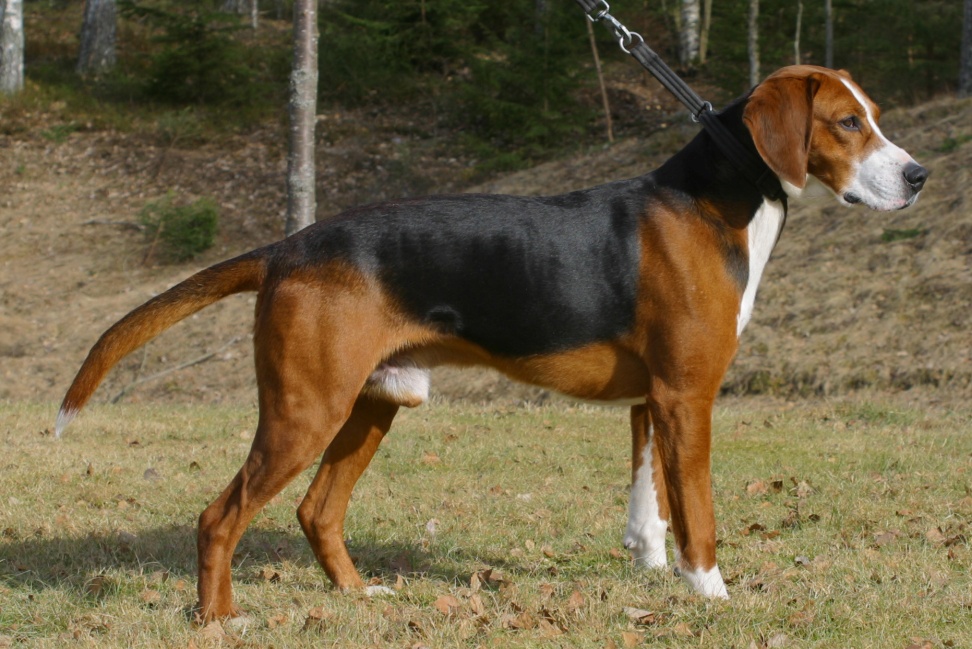 | Fédération Cynologique Internationale |
FCI-Standard N° 132
Hamiltonstövare

These illustrations do not necessarily show the ideal example of the breed.
The sequence might differ slightly from the original breed standard.
ORIGIN
: Sweden.DATE OF PUBLICATION OF THE OFFICIAL VALID STANDARD
: 17.07.1997.UTILISATION
: Scenthound that gives tongue and is used for hunting hare and fox. It is not a pack hound and it is never used for hunting deer.FCI-CLASSIFICATION
:| Group 6 | Scent hounds and related breeds |
| Section 1.2 | Scenthounds, Medium-sized Hounds |
| With working trial | |
TRANSLATION
: Renée Sporre-Willes.BRIEF HISTORICAL SUMMARY
: Houndbreeds have been known in Sweden since the 16Th century. Hunting with hounds was up to 1789 a privilege for royalty and gentry only. It was not until the end of the 18Th century that the ban that had prevented the peasantry from hunting the land was lifted. Hounds earlier kept only by the nobility became known and commonly spread. The origin of the Hamiltonstövare is believed to be a mixture of scenthounds from Southern Germany, Switzerland as well as Foxhounds and Harriers. At the first Dog Show in Sweden in 1886 some 189 scenthounds were on exhibition. Among them were a dog and a bitch, named Pang and Stella, owned by Count Adolf Patrik Hamilton. This couple is considered the origin of the Hamiltonstövare, or as the hounds initially were called, Swedish hound. The breed gained the name Hamiltonstövare in 1921 as an honour to the man that had created the breed, the founder of the Swedish Kennel Club, Count A.P. Hamilton.GENERAL APPEARANCE
: Well proportioned, giving impression of great strength and stamina. Never heavy. Tricoloured. The differences between male and female dogs should be clearly defined.IMPORTANT PROPORTIONS
: Rectangular body.BEHAVIOUR / TEMPERAMENT
: Friendly and even tempered hound.HEAD
: Longish head.CRANIAL REGION
:Skull
: Skull slightly arched and moderately broad.Stop
: Stop well defined but not too pronounced.FACIAL REGION
:Nose
: Nose always black, well developed with large nostrils.Muzzle
: Muzzle long, strong and almost rectangular. Bridge of nose straight and parallel to line of skull. Distance from occiput to stop should be equal to that from stop to tip of nose.Lips
: Upper lips rather thin, tight, nicely rounded and not too overhanging. Males should have more pronounced lips than females.Jaws/Teeth
: Scissor bite. Teeth strong and well developed.Cheeks
: Cheeks lean.Eyes
: Dark brown with calm expression.Ears
: Set fairly high ; when drawn forward, ears not to reach half-way along muzzle and should be raised only slightly when alert. Soft, hanging flat with fore edge not folded out.NECK
: Long, powerful and well set on into shoulders. Skin on neck supple and close fitting. Males should have a well defined arch of the topline.BODY
:Withers
: Withers well defined.Back
: Back level and powerful.Loin
: Loin musclar and slightly arched.Croup
: Croup slightly inclined, long and broad.Chest
: Chest deep, long, well developed and reaching elbows. Ribs moderately sprung.Underline and belly
: Belly only slightly tucked up.TAIL
: Set in line with back. Straight or slightly curved in sabre fashion. Fairly wide at base and tapering towards tip. In length it reaches hock. When the dog moves, tail preferably not carried above the level of the back.LIMBS
:FOREQUARTERS
: Strong bone in harmony with the general appearance of the dog. When viewed from front, forelegs appear straight and parallel.Shoulder
: Shoulder long, muscular and well laid back. Closely attached to body.Upper Arm
: Upper arm long and forming a right angle to the shoulder.Elbow
: Close to body and not visible under ribcage.Pastern
: Springy and forming a slight angle to forearm.FEET
:Forefeet
: Oval in shape with well knuckled, tight toes.Hind feet
: Like front feet, dewclaws undesirable.HINDQUARTERS
: Strong and parallel when viewed from behind.Thigh
: Muscles well developed ; thighs broad when viewed from the side.Stifle
: Well angulated.Hock joint
: Well angulated.Rear pastern
: Short, lean and straight.GAIT / MOVEMENT
: Parallel, strong, and long-reaching.COAT
:HAIR
: Harsh, not too short, lying very close to body. On head, ears and front of legs coat should be very short and smooth. Under tail and on back of thighs top coat quite long but not forming a fringe.COLOUR
: Tricolour. Upper side of neck, back, sides of trunk and upper side of tail black. Head, ears and legs, as well as the side of neck, trunk and tail tan. Tan can range from golden tint to a rich, deep reddish-brown. Blaze on upper part of muzzle ; under- and upper side of neck, breast, tip of tail and lower part of legs together with feet white.SIZE
:Height at withers
:Males 53-61 cm; ideal size 57 cm (22,5 ins.).
Bitches 49-57 cm; ideal size 53 cm (21 ins.).
FAULTS
:Any departure from the foregoing points should be considered a fault and the seriousness with which the fault should be regarded should be in exact proportion to its degree and its effect upon the health and welfare of the dog.
- Lack of masculinity or femininity.
- Broad skull, pronounced occiput.
- Short or snippy muzzle, dish-face.
- Heavy cheeks.
- Light eyes.
- Overshot - or undershot mouth, level bite.
- Soft back.
- Short, steep croup.
- Tail carried above the line of the back.
- Steep shoulder blades.
- Restricted hind movement.
- Mixture of black and brown colour.
- Heavy black markings that covers sides of trunk, shoulders and thighs.
- Other white markings than those described in the standard.
- Two-coloured ( yellow-white, black-white, black-tan) or any preponderance of any of the three permissible colours.
DISQUALIFYING FAULTS
:Aloofness.Pronounced over- or undershot bite.Size outside the maximum and minimum limit.Any dog clearly showing physical or behavioural abnormalities shall be disqualified.
